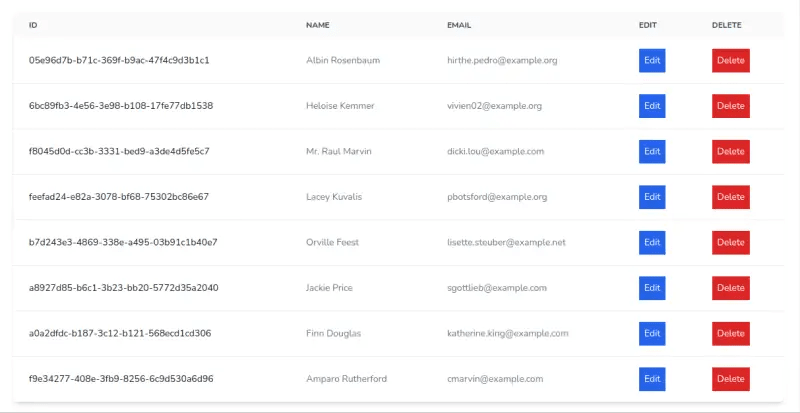In this section, we will see how to incorporate fake data directly into Blade files without the need to create a factory file. Utilizing the fake() helper method, you can swiftly prototype designs and populate them with simulated data.
<table class="w-full text-sm text-left text-gray-500 dark:text-gray-400">
<thead class="text-xs text-gray-700 uppercase bg-gray-50 dark:bg-gray-700 dark:text-gray-400">
<tr>
<th scope="col" class="px-6 py-3">
ID
</th>
<th scope="col" class="px-6 py-3">
Name
</th>
<th scope="col" class="px-6 py-3">
Email
</th>
<th scope="col" class="px-6 py-3">
Edit
</th>
<th scope="col" class="px-6 py-3">
Delete
</th>
</tr>
</thead>
<tbody>
@for ($i = 0; $i < 8; $i++)
<tr class="bg-white border-b dark:bg-gray-800 dark:border-gray-700">
<th scope="row" class="px-6 py-4 font-medium text-gray-900 dark:text-white whitespace-nowrap">
{{ fake()->unique()->uuid() }}
</th>
<td class="px-6 py-4">
{{ fake()->unique()->name() }}
</td>
<td class="px-6 py-4">
{{ fake()->unique()->safeEmail() }}
</td>
<td class="px-6 py-4">
<button class="p-2 text-sm text-white bg-blue-600">Edit</button>
</td>
<td class="px-6 py-4">
<button class="p-2 text-sm text-white bg-red-600">Delete</button>
</td>
</tr>
@endfor
</tbody>
</table>








Top comments (1)
Why laravel 9 when 11 is the current?